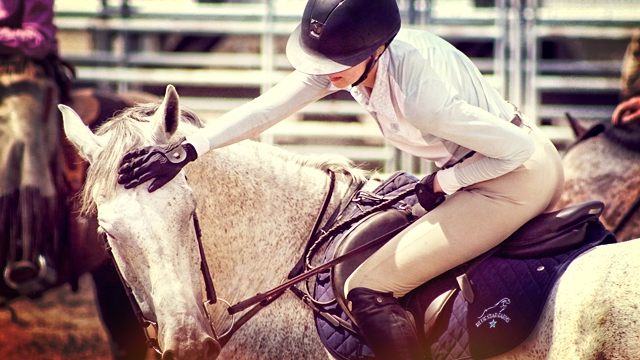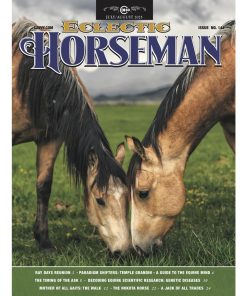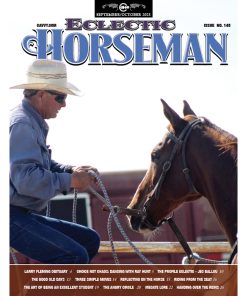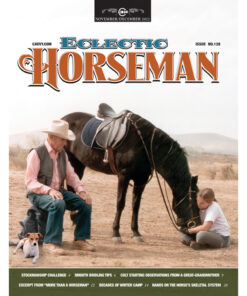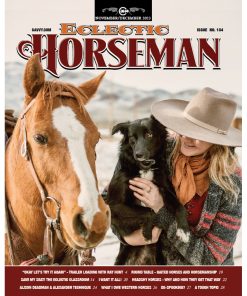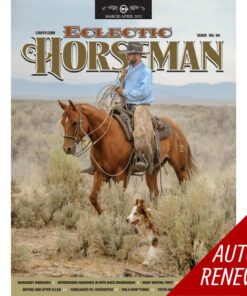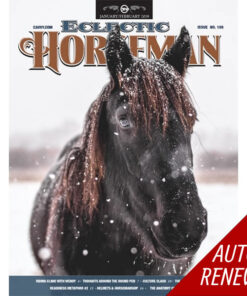This article is from issue No.109
I am a young professional based out of Longmont, Colo., and spend much of the year competing with my clients on the “A/AA” Hunter/Jumper circuit. Superficially my clients and I fit all the stereotypes: we ride around on imported, fancy warmbloods, wear our hair up in hairnets under our helmets, and heaven forbid there is a speck of dust on our highly polished custom black tall boots. How do we fit in at a clinic in the rural town of Kiowa, Colo., where the clinician is wearing chaps and a cowboy hat and the other clinic participants are a mixture of working cowboys, pleasure riders, and some cutters? What does this have to do with jumping horses? We are a competitive show barn, so what can we learn from this non-competitive environment and the philosophical teachings of good horsemanship?
On the show circuit, we operate in such a high-pressure environment. We travel thousands of miles a year to attend some of the biggest shows in the country. The junior riders share pictures on social media of themselves with their horses moving up to jump bigger fences or wearing the colorful ribbons that they have won. This is the antithesis of the teachings of good horsemanship and some may argue that good horsemanship and competition cannot be reconciled. It certainly would be easier if I just ran a school horse program, or a pleasure horse boarding facility, or just lived way out in the middle of nowhere with my own horses, but ever since I was a small child my love has always been showing hunters and jumpers. I am so fortunate to now have that as my career and be in the position to be able to influence and shape how people, particularly junior riders, view and understand the horse.
I believe that education and exposure to quality horsemanship is key to building confidence in the saddle but even more importantly I feel the responsibility to the horse to educate my riders and help develop them into empathetic and thinking horsemen. Unfortunately, in the Hunter/Jumper world, it’s fairly common practice that if a horse is too much for the rider to handle or the horse won’t load in to the trailer, to just give the horse a sedative. Furthermore, it’s common that if a horse doesn’t want to go over a particular jump, to just get behind it with a longe whip and scare it over. While I don’t believe these trainers, some of whom are quite accomplished in the saddle, have any bad intentions, I want to show my riders that there is another way. I want to get them thinking and searching to find out what helps them communicate with their horses in a manner that fosters a willing partnership and helps the horse to truly understand and be confident in its job.
It was a snowy day back in March and I came to the conclusion that many of my riders had reached a level of maturity and open-mindedness where they would be able to take in and appreciate working with a great horseman on some more subtle exercises and perhaps pick up a deeper philosophical understanding of the horse. I took the next step and sent an email to my clients asking if they would like to attend a clinic with Buck Brannaman. To my utmost delight I received an overwhelmingly positive response that they would be thrilled to attend the clinic. I brought eight horses and nine riders plus auditors to Buck’s clinic in Kiowa, Colo., in August.
My clients all know that I have worked closely with Mindy Bower, that I have attended numerous clinics with Buck, and they are familiar with the groundwork and under saddle-exercises which I incorporate into my program for our hunter, jumper, and equitation horses, but actually bringing them to the clinic was a huge leap. As the clinic approached, there was quite a bit of nervous energy. They all expected that the experience would help them connect to their horses in some way, but they had all only been to hunter/jumper clinics which are formatted quite differently.
Learning and growth happens when one leaves one’s comfort zone. On the first day a number of my riders, particularly the junior riders, were quite scared and intimidated either by Buck’s presence or by the situation as a whole. “We are the only ones in boots and breaches and English saddles!,” was something I heard quite a bit on the first day. “Should we be wearing something else so we fit in?” I assured them that by the shear fact that they were there and had brought with them an open mind and eagerness to learn that their clothing was superficial and irrelevant, and what mattered most was how they presented themselves internally to their horses.
One junior rider commented, “I was really worried that no one there would like me because I was an English rider and they were all western. I felt like we would all stick out and that people wouldn’t like us for that. I was really surprised after the first day because everyone was so kind, helpful, and inclusive. Everyone was so nice and that helped make it a really good experience. I am so grateful for everyone’s hospitality and kindness!”
As the clinic progressed, my riders began to make connections to how the various exercises in the clinic would help them with their jumping. Jumping and getting the correct distance for your horse to take off to the jump from is all about feel, timing, and the control of the horse’s feet. The work we do jumping our horses is fast yet precise and they learned how much could be accomplished at the walk and slower gaits to help them obtain the precision at the canter and when jumping. As they connected the dots, they began to feel more purpose to their riding and realized how the various exercises directly related to jumping.
A particular “ah-ha” moment for my riders was when Buck had each rider help their horse hook on to a herd of cows using exercises that my riders had just done in the earlier class. It was fascinating to watch each individual horse’s response. Some seasoned roping, ranch, and cutting horses wanted nothing to do with the herd of cows, or there was anxiety brought up in some of the horses. “We can do this exact exercise but with a jump instead of a herd of cows!,” I enthused to my riders. I asked them to think about whether their horses jumped because we told them to or they jumped because it was our idea that we set up to become their idea. What is your horse’s mental state when you jump? Is he worried, anxious, or confident? Does he seek the jump because he finds peace there?
I felt that is was extremely important for my riders to see Buck ride and lead such a fluid and seamless dance with his horses. If only we could feel or obtain a fraction of that. The question-and-answer session that each class started out with was fascinating, too. Buck is the horse’s biggest advocate, and he reminded us all what a privilege it is to ride these magnificent and generous animals, something that can be a bit forgotten or overlooked, especially in the show world. Buck also shared with us some insights and wisdom that has generated thoughtful discussion long past the clinic.
To add one more piece to the weekend, Kevin and Mindy, the clinic sponsors, kindly opened up their beautiful Uh-Oh Ranch for all of us to stay at. The junior riders, some of whom had never camped, stayed in tents outside the bunk house and not only got to bond with each other in the evenings but also meet and had some down time to discuss the clinic with other young clinic participants who were staying at the Uh-Oh Ranch. Taken collectively, the experience led to a magical weekend that transformed how they view their horse and heightened their awareness of themselves and how they interact with their horse.
Upon returning home, the riders commented that the clinic was one of the major highlights of the summer. They enjoyed learning in a zero-pressure environment, felt comfortable to experiment and learn from mistakes, and they all said how welcome they felt by all the clinic participants, and particularly Buck. Although I do incorporate groundwork and under-saddle exercise into my program, and I have helped many of my riders work through issues with trailer loading, the mounting block, bridling, etc., and many of them have watched Mindy and me start a colt together, they all felt that they were able to see how the pieces fit together after attending the clinic. My riders felt inspired to keep searching, experimenting, and thinking to find a better harmony with their own horses.
One of the junior riders commented, “I wasn’t expecting to be able to use the skills I learned in the show ring and when I am regularly jumping. It was so interesting so see how much of an impact it makes on the way you see your ride. The methods Buck used definitely helped with getting my horse balanced and to make my turns more efficient and smooth. I didn’t realize how important gaining control of the feet, the way Buck was, could impact your ride so much especially when you are jumping and controlling the horse’s track.”
Our experience at the clinic was one more step in my riders becoming independent, knowledgeable, and confident horsemen. The majority of the riders I brought to the clinic were juniors or young adults. My hope was to enthuse the younger generations of riders to this approach and expose them to quality horsemanship early in their experience with horses. I would love for even one or two of the riders to become as excited by and dedicated to good horsemanship as I have become because of the wonderful experience they had at this clinic and future clinics they will attend without a wreck or disaster leading them there. I would love for each of my riders to eventually have the tools and the confidence to use when they encounter a horse that might have a lot of go, that won’t get on a trailer, or that is worried about a jump and not resort to shortcuts that don’t help the horse learn in a good frame of mind.
While we will continue showing throughout the fall and will be attending both local and national shows, my hope is that my riders get the greatest sense of reward and joy, not from the ribbons they win, but from the journey; the people they have met, the horsemen that have opened their minds and inspired them, and from the time spent with their horses. In the show ring there are situations that are out of the rider’s control and riders spends more time “losing” than “winning”; there might be 36 rides in a class but only one blue ribbon gets awarded. Regardless of the day’s outcome, I want each rider to find the biggest reward of the day in the time they have spent with their horse. That may be a bit of a utopic vision and is certainly much easier said than done but I believe through education, exposure to good horsemanship, and my example that I can get my riders to start thinking that way.
During the writing of this article, my barn is competing at a show at the Colorado Horse Park which is our first show after the clinic. The riders who attended the clinic are overall more relaxed and centered and seem to be more focused on the process than the outcome of their rides in the show ring. One horse in particular gets quite antsy while waiting between classes. He would paw or kick and need to move. I was able to simply tell the rider to work in a short serpentine then offer him a place to stop. With just a few minutes of work he stood like a gentleman. I had another rider who made a mistake getting her horse to the correct distance to take off to the jump from. This horse and rider have had issues with the horse stopping at the jumps in the past, especially if the distance wasn’t correct. After the clinic we had spent a lot of time getting her horse to hook onto and find the jump on a totally loose rein. Her horse confidently stepped in and got them safely to the other side of the jump and they went on like nothing happened. When the rider came out of the ring she was crying. I thought maybe she was upset about the mistake but she said she was so emotional because of the tremendous generosity of her horse. She wrapped her arms around him and thanked him for all that he gives her.
Something else that struck me was about halfway through the five-day-long show I walked back to the area that we were stabled and noticed we only had a few ribbons hanging at our barn. It’s customary to hang all the ribbons that all the horses who belong to a particular barn have won in the stabling area. Our horses had been placing quite well in their classes, so I asked the riders where all the ribbons were. They looked at me and shrugged and said, “That’s not why we are here.” I was astonished and delighted at their response. Their main motives were to go somewhere different with their horses, jump some beautiful courses, share each other’s company, and get to know themselves and their horses better. I couldn’t believe the level of maturity that a group of teenage girls demonstrated and how their priorities had changed. The ironic thing is that with the shift in priority, the horses and riders have actually been preforming better and winning more!
I encourage everyone, whether you are a competitive show rider, ride for work, or ride for pleasure, to go out and try something different and work with the best horsemen you can. Look past a given rider’s dress and breed of horse they are riding because at the end of the day your horse doesn’t care what costume you dress up in to ride, what their breeding is, or how much they cost. It’s truly incredible what our horses will give to us, whether crossing a scary bridge, cutting a cow, or jumping a Grand Prix course, when they are in a peaceful frame of mind, and understand and seek the job or task at hand. It takes tremendous sensitivity, empathy, and personal discipline to work with horses. I believe that by exposing my riders, particularly my junior riders, to the highest quality of horsemanship, they will not only grow as riders but as people.
Our horses will always tell us the truth about what is inside of us. While the pursuit of good horsemanship is a lifelong journey, because of the clinic, my riders have gained a new set of exercises to help them with the precise work of jumping but deeper than that, they have begun to think about how to present different situations to the horse in a peaceful way to help the horse connect to the job. They have begun to see how much more our horses can offer us whether they are just enjoying time with their horse or are in the show ring. By letting go of outcome-based motives, they have begun to find the greatest reward in the process and the greatest joy in the time they spend with their horses, and in return our horses have been happier, more confident, and have better performed their jobs. While autumn sets in, the days get shorter, and the show season winds down, I look forward to continuing to work on the various exercises from the clinic with my riders and relate them back to show jumping, and thinking about what clinics we will attend next year and what other educational opportunities I can open up for my riders. What unlikely places will your horsemanship journey take you next?

